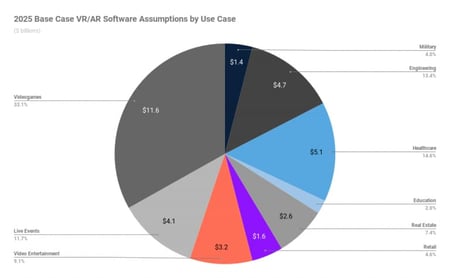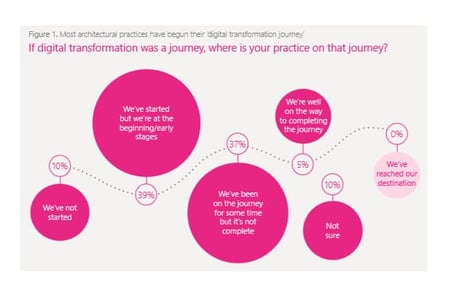You might be noticing, even in your own school or office, that technology is becoming more and more prevalent and useful as time goes on. We’re all slowly adapting to how technology, no matter the kind, can be beneficial for daily tasks when utilized well, and we’re loving it!
The satisfaction is unbelievable when you can walk into a room and own the technology around you without complications during major or routine tasks. *cue mic drop*

And shouldn’t that be how you feel all the time when you’re using technology in the workplace? Technology should be something you can rely on to bring your work to that next level – It should be a compliment as opposed to causing friction – and that’s exactly what we’ll see going forward – more technology that compliments our work and daily routines with less roadblocks and inefficiencies to slow you down.
We’re moving into an age of business-ready digital transformation within the A&D space, which means that we’re beginning to adapt technology, and ultimately it’s changing how we work, how we communicate and how we create or maintain our working relationships. Remember when Skype was first introduced, or even MSN Messenger? It was revolutionary because it was an instant way to communicate with someone without picking up a phone, and you could stay at your desk and multitask while collaborating with your peers – that’s what digital transformation is all about.
The future of VR
Technology is advancing in ways that fit our workflows better, in fact, within the next 5-10 years, we’re going to witness mass VR adoption in the workplace. It’s expected to become the next major computing platform, and it’s even being compared to the rise of the smartphone! (Remember way-back when no one had a smartphone and then suddenly EVERYONE had one? VR technology is expected to be the same!) Even students are learning how to work with virtual reality before they enter the workforce to better prepare themselves for this digital transformation! This crazy change is coming full-force, but it’s not going to affect you and your business, right?
Well, maybe see for yourself. Take a look at this graph from Goldman Sachs Profiles in Innovation report where you see their prediction for where VR/AR is going to be used by-industry – as you can see, it’s drastically different than what’s relevant in today’s workplaces, so it’s extremely plausible that this tidal wave of a technology shift is headed your way too. According to this study, about 35% of architectural firms are already using some form of digital reality in their firms today and have plans to expand in the future, and separate from those, 29% of the firms in the study are looking into adopting the technology within the next 5 years.

With that, we’re going to see more and more people adopting virtual reality as it’s coming out - VR/AR tech will provide more opportunities for practicality and usability within the workplace.
In a survey done by Microsoft and RIBA Architecture, a respondent said, “It’s a different way of working, a new process model and [it’s] more agile, where data is produced once, and is used many times for more tasks”... Pretty revolutionary stuff if you ask me!
The key to productivity
Digital transformation is not just the adoption of new technology, but rather it’s a fundamental shift in culture supported and based within technology. 56% of survey respondents recognize that the digital transformation is going to create better atmospheres to complete work in while also improving client outcomes in the process, so a lot of employees are going to be looking for this cutting-edge technology in their workplace. You also have to keep in mind that by 2025, millennials will make up 75% of our workforce and a study by Penn Schoen Berland found that 77% of millennials interviewed WANT to use VR/AR because they think it will make their jobs more productive. So if millennials are on-board with it, then we better take initiative and get the tech while it’s ripe and before your competition blows you out of the water with it.
The key to survival??
For the architecture and design communities, the VR adoption isn’t really an option. In fact, 55% of survey respondents actually say, whether their firms adopt the technology or not is going to be a HUGE factor for whether or not their business will stay relevant or even thrive going forward. With this being the general opinion, we’re seeing a lot of firms slowly investigating what they need to do to keep up with their competition, and their employees and customers expectations of what they should be delivering.
Research shows that many architects see the great potential of digital transformation and how it can bring great improvements in efficiency in particular. I mean, take for instance how architects and designers used to go about their design processes. Originally it was old-school pencil on paper and small-scale replica models, then we started seeing the evolution of the computer and designers were able to achieve more complex iterations like accurately-scaled down floor plans and 3D-models created from CAD programs, and now that digital reality is taking the fore-front, there is so much potential in the realm of virtual, augmented and mixed realities as well that can be applied to designers work. Digital reality technology has the power to bring designs to life, enabling clients to really experience a design before it’s tangible. Team members, clients, and contractors work together as virtual teams, exploring, reviewing and agreeing on design choices - and then they can even put the client into the heart of the design, leaving no room for misinterpretation. This won’t only save time and money in the initial stages – but it’ll ultimately minimize on-site or post-construction design changes that can be extremely costly.
More than half of the architects and designers that were surveyed agree that within the last 5 years, there have been huge changes in their workplaces in terms of digital transformation, specifically around how projects are delivered to clients. 41% said their journey has drastically changed the way that their business runs and almost 90% agree that digital reality is transforming how they’re currently working - so why are businesses so hesitant to adopt VR/AR if there’s such a strong demand for customers, employees, AND overall productivity??
What if you’re not sure where to start?
Sometimes digital transformation within a firm gets lost. 10% of individuals surveyed don’t know where they fall on their journey, but that’s not because they don’t want change within the workplace - it’s usually because the next steps, technologically, aren’t clear. For instance, VR has commonly been this ‘hyped’ technology that people use for cool roller coaster experiences and the odd video game up until a couple of years ago, so obviously if that's the common assumption, you wouldn't invest big bucks either. What a lot of people don’t know is that VR technology has reached a mature point where businesses can find practicality using it. Over ⅔ of architects voice that cost is a huge challenge when it comes to adopting VR for big and small firms alike. Now that the Oculus Go has hit the market as the first stand-alone VR headset ever, there are less friction points for mobile VR versus tethered, but there still has to be significant research into the platform you choose, which means a fairly large time investment from the get-go. Training is also an important consideration - over half of the participants in the study agree that learning curve for the platform, or amount of training required could be a major setback, and could prevent firms from investing.
Our tip is to find a VR solution that mends well with working practices you already live by. Whether that means you find something that has a user-friendly interface that’s simple enough that a senior-level exec can use it, one that works with CAD programs you already use and is compatible with content you already own, and one that has the least amount of barriers when it comes to presenting design iterations to clients. The VR solution you choose shouldn’t cause a lot of friction in your business workflow, otherwise you won’t see the ROI you’d expect to see from adopting the technology (and not to brag... but Yulio does all of these things already and you can have 30 days free to test it out for yourself!).

Because there’s finally this reassurance in the market of VR/AR, businesses are finally trusting their instincts to move forward alongside the technology curve. Most of the people who were a part of this research were in the process of some sort of digital transformation journey for their firm. As illustrated in the graph above, 39% said that they were still in the early stages of adoption and 37% had been investigating and adopting the technology for some time now - but in comparison, 10% of their surveyors had not even started looking into the tech yet - and this could be fatal to businesses considering how fast the lack of a technological-edge can leave you in the dust. There are very few firms who believed that they completed their digital transformation journey, but that makes sense because a digital transformation does not necessarily have a means to an end - it’s an ongoing process of change and will continue to adapt with time and technological shifts - so there may never be an absolute end to the journey, but there’s definitely a path that you can start going down to make sure that you’re keeping up with the times.
The important takeaway from all of this research is that if you’re not already investigating a VR solution for your practice, now might be the time! Learning about the VR industry and getting started with VR solutions is a lot faster and more user-friendly than you may think.
Here at Yulio, we take all of this research and their findings (along with 1000+ hours of our own research and user-testing) to heart, and we try and break down the barriers for you to create the best business-ready VR experience possible for you and your clients! With our guidance, you can get up-and-going in as little as a day, seriously. Check out our guiding steps to getting started with a VR solution for your business here! Want to learn more about VR for business before investing? Read our whitepaper on achieving ROI for your business using virtual reality here.




.jpg?width=245&height=150&name=active-adult-beautiful-1799244%20(1).jpg)
